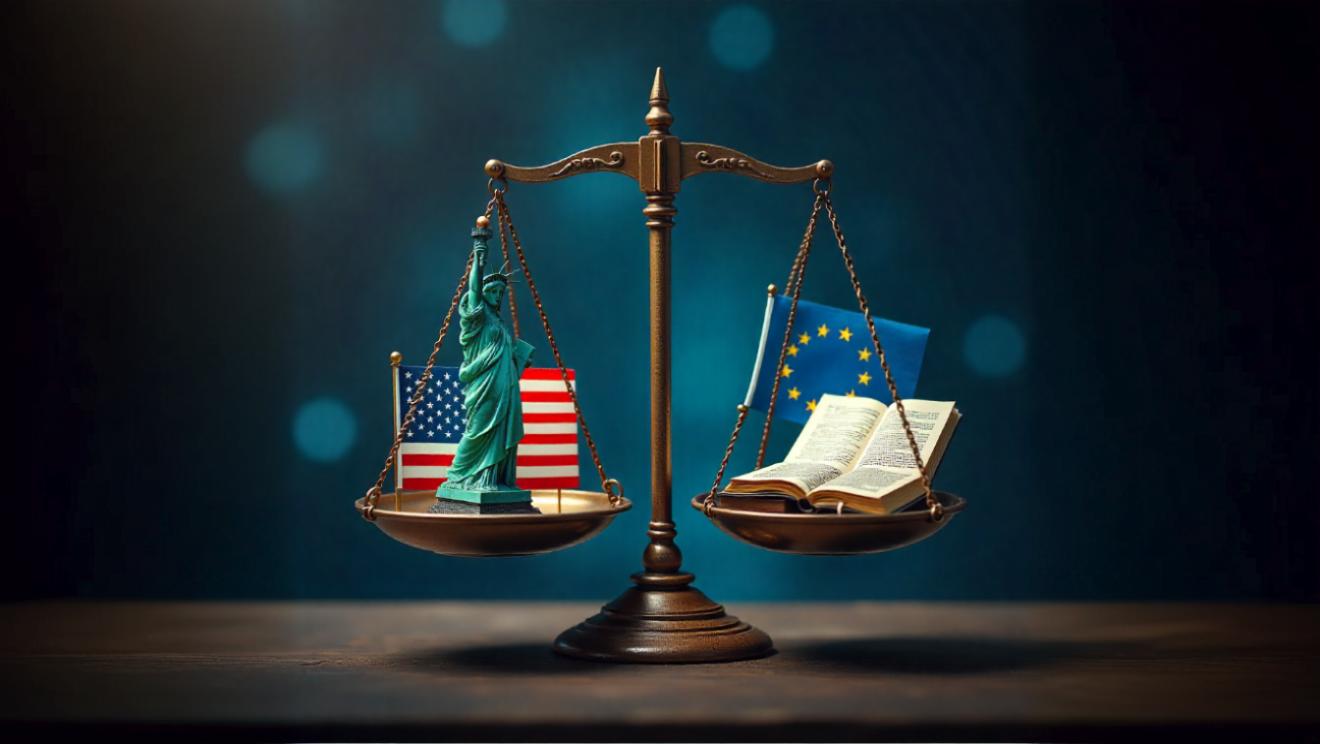Artificial intelligence has become an engine of global transformations, and the way in which major powers choose to approach and regulate it differs radically. The United States and the European Union present two diametrically opposed models of governance: one flexible, focused on fostering technological innovation, and the other preventive, aimed at prioritizing the protection of fundamental rights and consumers’. A proper understanding of these differences is essential for both the business and legal environments, as artificial intelligence (AI) has become an indispensable utensil in companies’ day-to-day activities. The use of an AI tool that either complies with or deviates from mandatory or voluntary legal standards, as the case may be, can be an important criterion in selecting a suitable instrument for a company’s individual needs.
USA – Market Freedom and Self-Regulation
On July 10, 2025, the Trump administration published the American AI Action Plan, a strategic document that upholds the traditional American philosophy: 'innovation outweights regulation'. This strategic document outlines the development directions for the immediate future, which, unlike past initiatives, introduces a more centralized and coordinated vision with concrete steps of action to be taken in each affected domain. The main directions outlined are:
- Technological leadership and competitiveness: massive federal investments in infrastructure and in fundamental and applied research on artificial intelligence to counter Chinese and European technological advances;
- National security and defense: AI is designated as critical infrastructure, with emphasis on applications in cyber defense, military intelligence, and national emergency situations;
- Minimal, sector-specific regulation: instead of a mandatory general framework, the plan encourages federal agencies to develop standards tailored to sensitive fields (healthcare, transportation, energy);
- Public-private partnerships: the government facilitates rather than regulates, mobilizing the private and academic ecosystems to accelerate innovation;
- Principles and values: the document highlights adherence to democratic principles such as freedom of expression and core American values.
The immediate impact of the plan is the consolidation of a flexible governance framework, designed to provide stability, strategic predictability, attract private investments, and support projects through budgetary funding. However, the absence of a uniform federal regime continues to raise concerns regarding regulatory fragmentation and the inadequate protection of consumers, which stands in sharp contrast to the European approach.
European Union – Preventive and Uniform Regulation
The European Union has chosen a diametrically opposed path, materialized through the adoption of the Artificial Intelligence Act (AI Act), the first comprehensive piece of legislation on AI adopted by a major international regulatory authority. The EU’s chosen approach is grounded in the principles underpinning the Union, which is why EU governance in the field of AI is preventive and uniform, centered on the principle of 'technology in the service of fundamental rights'.
The legislative framework relies on several instruments that function in a complementary manner:
- Risk-Based Classification: ranging from systems that are entirely prohibited (e.g., real-time biometric recognition in public spaces) to those with minimal risk (AI-powered video games, anti-spam filters), with proportional obligations;
- Code of Practice for General-Purpose AI Models – addressing transparency (obligation for providers to document models and publish contact details so authorities can request access to this information), copyright (clarifying liability in cases involving the use of copyright-protected data), and security and safety (measures to prevent systemic risks);
- Continental AI Action Plan – published in April 2025, outlining the strategy to support AI along five axes: computing infrastructure (AI factories and gigafactories funded with billions of euros), data governance, skills development through academies and training programs, accelerating AI adoption in strategic sectors, and simplifying rules for the implementation of the AI Act;
- Template for Summarizing Training Data of General-Purpose AI Models – establishing the reporting format set by the EU AI Office for the summary presentation of training data used in AI models, in compliance with the requirements of the AI Act.
The impact is twofold: on the one hand, it increases the level of legal protection and public trust, but on the other hand, it generates high compliance costs for small companies and slows down innovation.
Thus, on the global map of AI-driven innovation, two fundamentally different approaches are emerging:
- The United States supports the adoption of minimal, sector-specific regulations, emphasizing competitiveness and national security, but offering reduced protection of copyright, fundamental rights, and the environment;
- The European Union perseveres with uniform and sanction-based regulation, aimed at ensuring long-term protection and providing legal certainty, despite high costs and increased rigidity.
As a result, multinational companies are compelled to adopt dual compliance strategies, being forced to manage simultaneously the dynamic, innovation-driven American model and the stringent European legislative framework.
The United States and the European Union put forward two opposing paradigms: one of accelerated innovation driven by the forces of the free market, and the other of preventive regulation through the letter of the law. At stake is not only who will win the race for artificial intelligence, but also the architecture of the digital society of the future. The question remains: who will set the global standards and whose model will prove its effectiveness over time – the U.S., through flexibility and self-regulation, or the EU, through protectionism and strictness? Or, as the classic proverb goes: when two fight, the third wins – will China be the superpower that dictates the rules of the game? Time will tell.
Co-authors:
Ioana Chiper Zah
Tatiana Tapu



